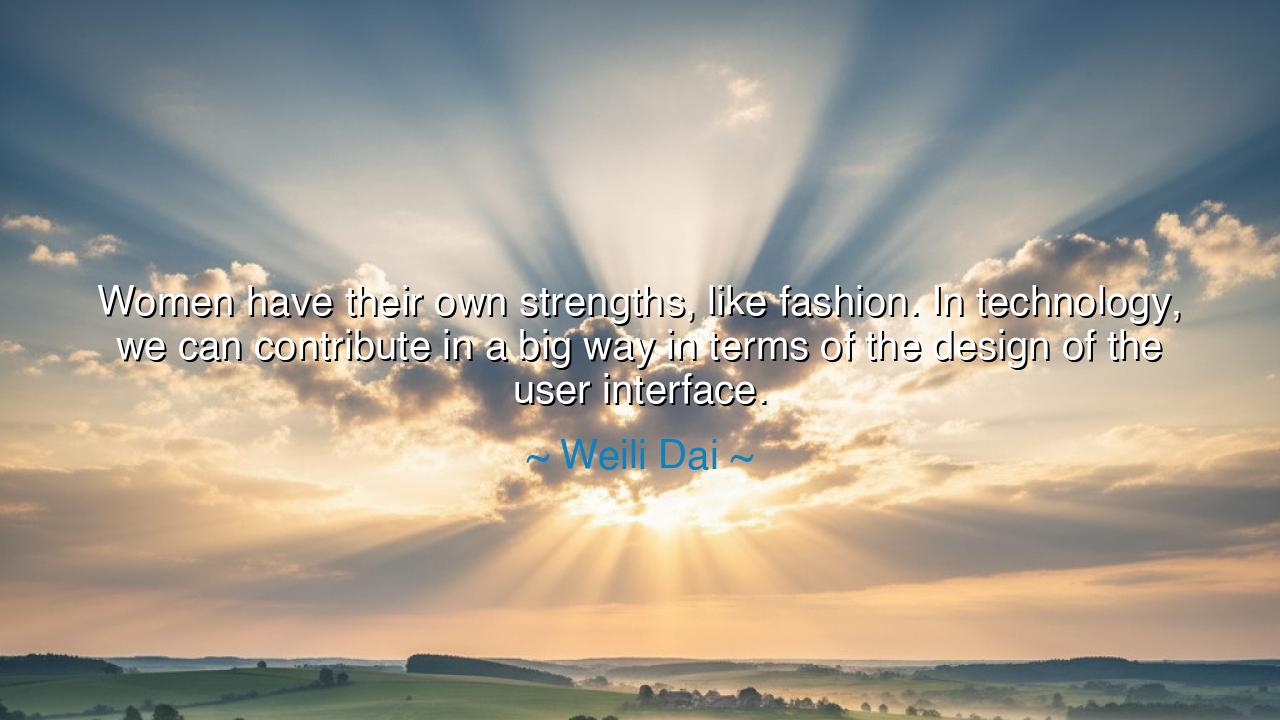
Women have their own strengths, like fashion. In technology, we
Women have their own strengths, like fashion. In technology, we can contribute in a big way in terms of the design of the user interface.






“Women have their own strengths, like fashion. In technology, we can contribute in a big way in terms of the design of the user interface.” Thus spoke Weili Dai, a pioneer of the digital age, co-founder of Marvell Technology Group, and one of the first women to stand as a titan in the world of microchips and code. Her words, though simple in form, carry the weight of centuries—the call for balance between reason and intuition, between logic and empathy, between the hard edges of technology and the grace of human understanding. What she speaks of is not merely design, but the union of art and intellect, the sacred marriage between function and feeling.
In these words, Weili Dai reminds us that strength is not singular. Too long have societies imagined power in narrow shapes—measured by dominance, conquest, or cold calculation. But Dai saw the world differently. She understood that true creation requires not only the sharp mind of the engineer but also the sensitive vision of the designer, the one who feels the human heart behind every tool. Fashion, in her eyes, is not vanity—it is the art of understanding people, of perceiving beauty, comfort, and expression. And in this same way, she saw that technology too must dress the soul, not merely serve the machine.
The user interface, which she names, is the sacred bridge between the human and the digital—the place where touch meets thought, where code becomes experience. For ages, men had built machines of great power but little warmth: efficient, yes, but distant, mechanical, unyielding. Dai recognized that the future would belong to those who could humanize technology, who could weave intuition and empathy into the circuits of innovation. In her vision, women’s natural attentiveness to detail, emotion, and connection would not only complement the world of engineering but transform it.
Consider the story of Ada Lovelace, the first computer programmer in history. She worked beside Charles Babbage, whose mind was consumed by gears and mathematics, yet it was Ada who foresaw that the machine they built could one day create music, art, and imagination. Where Babbage saw calculation, she saw creation. She, like Weili Dai, perceived that the purpose of invention was not simply to compute, but to extend the boundaries of human potential. And so, across centuries, the same truth echoes: that innovation thrives not when it forgets humanity, but when it embraces it.
Weili Dai’s wisdom also speaks to the integration of feminine insight into the modern world. She does not separate the feminine from the technical; she unites them. She proclaims that the grace once confined to fashion and aesthetics can, and must, inform the great designs of technology. This is not a call for division, but for harmony—the blending of creativity and precision, of empathy and logic, of beauty and efficiency. It is a reminder that progress without compassion is cold, and that every innovation must ultimately serve the dignity and comfort of the human being.
Her vision extends beyond gender. It is a lesson for all creators, men and women alike: that every discipline requires both structure and spirit. The great cathedrals of old were not raised by mathematics alone, but by faith and artistry; the masterpieces of the Renaissance were born not from reason alone, but from passion guided by intellect. In the same way, the designers of the digital world must learn from both the engineer and the artist, for the world that serves humanity must also reflect its soul.
Thus, let the words of Weili Dai be carried forward as a teaching to the generations: honor the balance of strength and sensitivity. Let technology be guided not only by speed and efficiency, but by care and empathy. Let innovation serve beauty as well as function, for only then will it truly serve life. And let every person, whatever their path, remember that their unique gifts—whether logical or aesthetic, practical or emotional—are all needed in the grand design of creation.
For in the end, as Dai teaches, it is not enough to build machines that think. We must build technologies that understand. The power of the future will belong to those who remember that every circuit must serve the heart, every design must respect the living form, and every act of creation must begin with the simple, eternal truth: that the measure of progress is not the brilliance of the tool, but the humanity it preserves.






AAdministratorAdministrator
Welcome, honored guests. Please leave a comment, we will respond soon